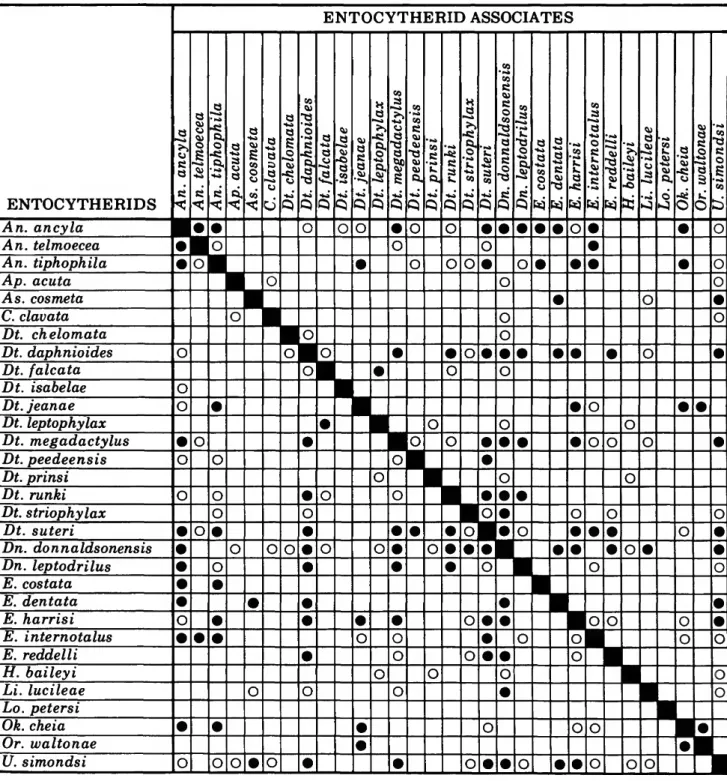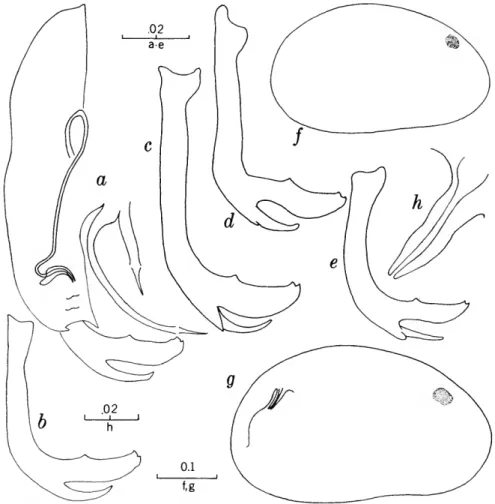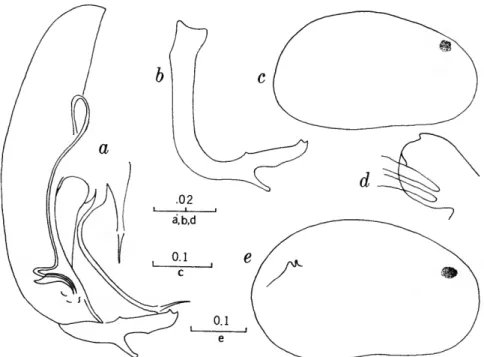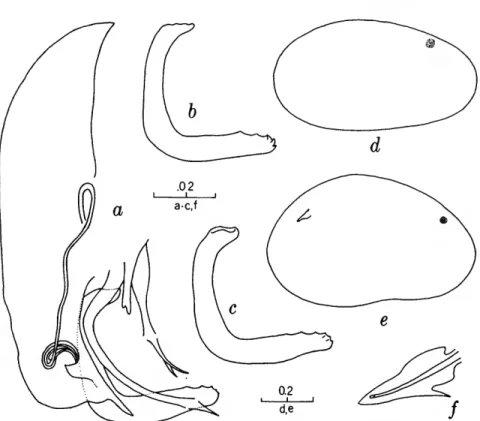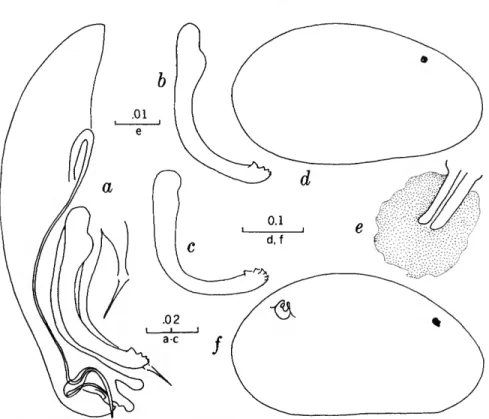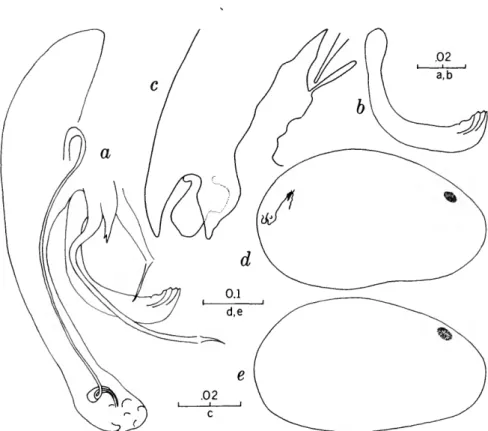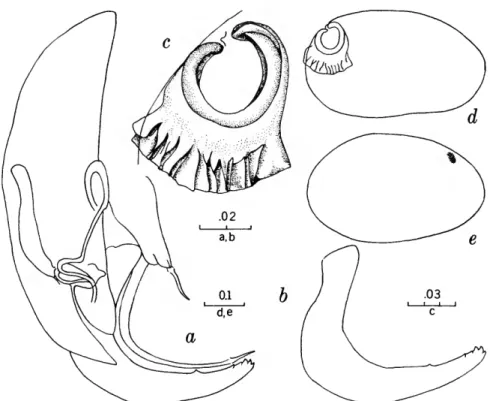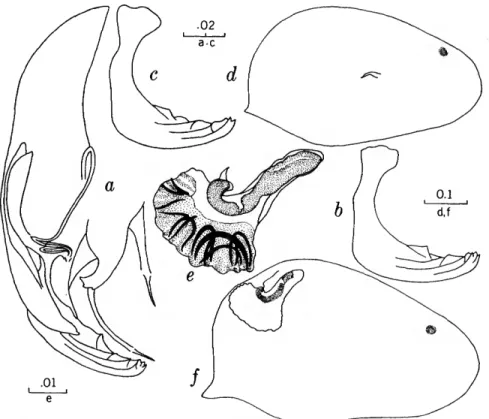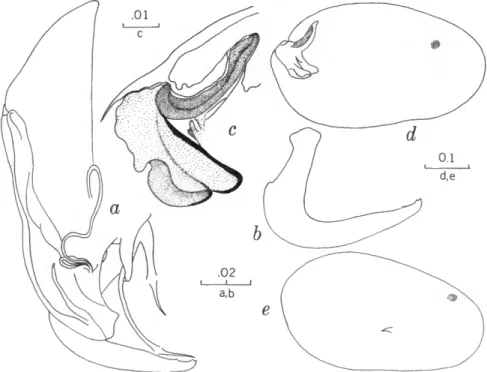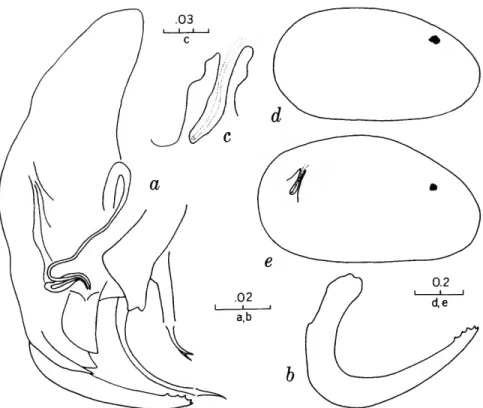HORTON H. HOBBS, JR.
and
DANIEL J. PETERS
SMITHSONIAN CONTRIBUTIONS TO ZOOLOGY • NUMBER 247
Emphasis upon publication as a means of "diffusing knowledge" was expressed by the first Secretary of the Smithsonian. In his formal plan for the Institution, Joseph Henry outlined a program that included the following statement: "It is proposed to publish a series of reports, giving an account of the new discoveries in science, and of the changes made from year to year in all branches of knowledge." This theme of basic research has been adhered to through the years by thousands of titles issued in series publications under the Smithsonian imprint, commencing with Smithsonian Contributions to Knowledge in 1848 and continuing with the following active series:
Smithsonian Contributions to Anthropology Smithsonian Contributions to Astrophysics
Smithsonian Contributions to Botany Smithsonian Contributions to the Earth Sciences
Smithsonian Contributions to Paleobiology Smithsonian Contributions to Zoo/ogy Smithsonian Studies in Air and Space Smithsonian Studies in History and Technology
In these series, the Institution publishes small papers and full-scale monographs that report the research and collections of its various museums and bureaux or of professional colleagues in the world cf science and scholarship. The publications are distributed by mailing lists to libraries, universities, and similar institutions throughout the world.
Papers or monographs submitted for series publication are received by the Smithsonian Institution Press, subject to its own review for format and style, only through departments of the various Smithsonian museums or bureaux, where the manuscripts are given substantive review. Press requirements for manuscript and art preparation are outlined on the inside back cover.
S. Dillon Ripley Secretary
Smithsonian Institution
S M I T H S O N I A N C O N T R I B U T I O N S T O Z O O L O G Y • N U M B E R 2 4 7
The Entocytherid Ostracods of North Carolina
Horton H. Hobbs, Jr.
and Daniel J. Peters
SMITHSONIAN INSTITUTION PRESS City of Washington
1977
A B S T R A C T
Hobbs, Horton H., Jr., and Daniel J. Peters. The Entocytherid Ostracods of North Carolina. Smithsonian Contributions to Zoology, number 247, 73 pages, 33 figures, 3 tables, 12 maps, 1977.—The entocytherid ostracods are obligate external symbionts of crayfishes, and in North Carolina comprise 31 species distributed among 13 genera. Except for five species that seem to be restricted to burrowing crayfishes, all infest more than one host species. Following a brief historical account of the studies of the species reported to occur in North Caro- lina are discussions of the topography and drainage systems of the State, ento- cytherid infestations and associates, hosts and the ostracods infesting them, zoo- geographic and ecological distributions, life history, and taxonomic characteristics employed in recognizing the North Carolina entocytherid fauna. Keys to the genera and species introduce the annotated list containing synonymies, diagnoses of the genera and species, type-localities, ranges, hosts, and entocytherid asso- ciates. Illustrations and distribution maps are also provided for each species. A new genus, Aphelocythere, is proposed to receive a previously unaescribed species, A. acuta. Five additional new species are included from the State:
Dactylocythere isabelae, D. peedeensis, Donnaldsoncythere leptodrilus, Ento- cythere costata, and Harpagocythere baileyi. Nine of the 31 species occur in the Coastal Plain Province of the State, 19 in the Piedmont, and 17 in the Mountain Province. Fourteen species are restricted to the Atlantic slope, four to streams draining into the Gulf of Mexico, and 13 occur on both sides of the Appalachian Divide.
OFFICIAL PUBLICATION DATE is handstamped in a limited number of initial copies and is recorded in the Institution's annual report, Smithsonian Year. SERIES COVER DESIGN: T h e coral Montastrea cavernosa (Linnaeus).
Library of Congress Cataloging in Publication Data Hobbs, Horton Holcombe, Jr., 1914—
T h e entocytherid ostracods of North Carolina.
(Smithsonian contributions to zoology ; no. 247) Bibliography: p.
1. Entoc) theridae. 2. Crustacea—North Carolina. I. Peters, Daniel J., joint author. II. Title.
III. Series: Smithsonian Institution. Smithsonian contributions to zoology : no 247 QL1.S54 no. 247 [QL444.086] 591'.08s [595'.33] 76-45928
Contents
Page
Introduction 1 Acknowledgments 1 Historical Account 2 Topography and Drainage Basins 3 Entocytherid Infestations and Associates 4 Hosts and Entocytherid Infestations 8 Zoogeographic Considerations 9 Ecological Considerations 11 Lentic Habitats 11 Lotic Habitats 12 Life History 13 Key to the Instars of Entocytherinae 13 Taxonomic Characteristics 13 Key to Genera of Entocytheridae Occurring in North Carolina 15
Family ENTOCYTHERIDAE Hoff, 1942 16
Subfamily ENTOCYTHERINAE Hoff, 1942 16
Genus Ankylocythere Hart, 1962 16 Key to North Carolina Species of Genus Ankylocy there 16 Ankylocythere ancyla Crawford 17 Ankylocythere telmoecea (Crawford) 18 Ankylocythere tiphophila (Crawford) 20 Aphelocythere, new genus 21 Aphelocythere acuta, new species 21 Genus Ascetocythere Hart, 1962 23 Ascetocythere cosmeta Hobbs and Hart 23 Genus Cymocythere Hart, 1962 24 Cymocythere clavata Crawford 24 Genus Dactylocythere Hart, 1962 25 Key to North Carolina Species of Genus Dactylocythere 26 Dactylocythere chelomata (Crawford) 26 Dactylocythere daphnioides (Hobbs) 28 Dactylocythere falcata (Hobbs and Walton) 29 Dactylocythere isabelae, new species 30 Dactylocythere jeanae Hobbs 32 Dactylocythere leptophylax (Crawford) 33 Dactylocythere megadactylus Hart and Hart 35 Dactylocythere peedeensis, new species 36 Dactylocythere prinsi Hobbs and Walton 38 Dactylocythere runki (Hobbs) 38 Dactylocythere striophylax (Crawford) 40 Dactylocythere suteri (Crawford) 41 Genus Donnaldsoncythere Rioja, 1942 43
iii
Key to North Carolina Species of Genus Donnaldsoncythere 43 Donnaldsoncythere donnaldsonensis (Klie) 43 Donnaldsoncythere leptodrilus, new species 45 Genus Entocythere Marshall, 1903 47 Key to North Carolina Species of Genus Entocythere 47 Entocythere costata, new species 47 Entocythere dentata Crawford 49 Entocythere harrisi Peters 51 Entocythere internotalus Crawford 52 Entocythere reddelli Hobbs and Walton 54 Genus Harpagocythere Hobbs III, 1965 55
Harpagocythere baileyi, new species 55 Genus Litocythere Hobbs and Walton, 1968 57 Litocythere lucileae Hobbs and Walton 57 Genus Lordocythere Hobbs and Hobbs, 1970 58
Lordocythere petersi Hobbs and Hobbs 58 Genus Okriocythere Hart, 1964 59 Okriocythere cheia Hart 60 Genus Ornithocythere Hobbs, 1967 61 Ornithocythere waltonae Hobbs 61 Genus Uncinocythere Hart, 1962 62 Uncinocythere simondsi (Hobbs and Walton) 63 Literature Cited 65 Maps 68
IV
The Entocytherid Ostracods of North Carolina
Horton H. Hobbs, Jr., and Daniel J. Peters
Introduction
The ostracods treated herein infest crayfishes on which they occur as obligate external symbionts.
Although occasionally invading the branchial cham- bers of the hosts, they occur in greatest numbers on setiferous areas or in crevices on the exoskeleton.
Insofar as is known, they do no harm to the cray- fish, and, if their presence on the host is beneficial to it, such has not been demonstrated.
The entocytherid fauna of North Carolina com- prises 31 species distributed among 13 genera. All of them are assigned to the nominate subfamily Entocytherinae, the members of which are restricted to Middle and North America and Cuba, and, except for one Mexican species (see below), all infest crayfishes of the families Astacidae and Cam- baridae. Of the 27 native crayfishes occurring in the State, only four are not known to harbor entocy- therids. With little doubt, a lack of adequate samples is responsible for our failing to report infestations on them.
In this study, we have attempted to compile all available information on the entocytherids occurring in the State, and, while collections are available from all parts of the latter, we have com- paratively few records from the southeastern seg- ment of the Tidewater region. Moreover, in all
Horton H. Hobbs, Jr., Department of Invertebrate Zoology, National Museum of Natural History, Smithsonian Institu- tion, Washington, D.C. 20560. Daniel J. Peters, York High School, P. O. Box 547, Yorktown, Virginia 23690.
probability, additional species will be found at lower elevations along the western slopes of the mountains.
As is evident in the treatment of the various species, except for their ranges, hosts, and a few ecological data, virtually nothing is known of the biology of any entocytherid occurring in the State.
A recent monographic review of the family, in- cluding summaries of what is known of the biology of the entocytherids, has been provided by Hart and Hart (1974). Inasmuch as this work includes complete synonymies for all except those species newly described here, we have limited our citations to the original description, synonyms, and references pertaining to North Carolina.
ACKNOWLEDGMENTS.—We wish to express our thanks to Joseph R. Bailey of Duke University and Jean E. Pugh of Christopher Newport College for their help in amassing many of the collections on which this study is based, and we are grateful to the following persons who have assisted us in obtaining additional specimens: Raymond W. Bouchard of the University of North Alabama, Joseph F.
Fitzpatrick, Jr., of the University of South Alabama, Edward T. Hall, Jr., of the Georgia Department of Natural Resources, C. W. Hart, Jr., of the Smith- sonian Institution, Georgia B. Hobbs of Falls Church, Virginia, Perry C. Holt of the Virginia Polytechnic Institute and State University, Frank O.
Perkins of the Virginia Institute of Marine Science, J. Dan Pittillo of Western Carolina University, Cathy Salmons of Elkin, North Carolina, Kenneth
W. Simonds of Epworth, Georgia, Nina H.
Singleton of Simsbury, Connecticut, and Warwick R. West, Jr., of the University of Richmond.
For assisting us in locating some of the maps utilized, we express our appreciation to Rowland M. Shelley of the North Carolina Museum of Nat- ural History. Edward F. Menhinick of the Univer- sity of North Carolina at Charlotte kindly lent us a manuscript copy of his Fishes of North Carolina for which we are most grateful.
We are indebted to Fenner A. Chace, Jr., of the Smithsonian Institution, Martha R. Cooper of the North Carolina Museum of Natural History, C. W.
Hart, Jr., Georgia B. Hobbs, and H. H. Hobbs III of Wittenberg University for their criticisms of the manuscript. We are especially grateful to Margaret A. Daniel of the Smithsonian Institution for her assistance in the preparation of the manuscript and for her renditions of the tables.
Historical Account
The earliest record of the occurrence of an ento- cytherid ostracod in North Carolina is that of Allen (1933:119-120) who reported finding Entocythere cambaria Marshall (1903:117) on Cambarus acumi- natus Faxon (1884:113) [= C. (Puncticambarus) sp.
C] collected near Durham, and on Cambarus blan- dingii (Harlan, 1830:464) [= Procambarus (O.) blandingii] near Charlotte. Inasmuch as this ostra- cod has not subsequently been found in the State, and several species occur in the areas mentioned, it is not possible to determine what species Allen encountered in her studies.
Twenty-two years elapsed before Hobbs (1955) described two new species, Entocythere daphnioides [= Dactylocythere daphnioides] and E. runki [ = Dactylocythere runki] from the New and Watauga basins, recording both, together with E. humesi Hoff (1943:282) [= Donnaldsoncythere donnaldsonensis], from Ashe, Avery, and Watauga counties, and E.
runki also from the Little Tennessee Basin in Swain County.
Two additional species were reported to occur within the State by Hobbs and Walton (1961:381) who noted that their Entocythere falcata [ = Dactyl- ocythere falcata] was widespread in the Hiwassee Basin and Entocythere hiwasseensis [ = Donnald- soncythere donnaldsonensis] was apparently limited to streams in "the upper reaches of the Nottely and Hiwassee rivers."
Crawford (1961:244), in describing Entocythere chelomata [= Dactylocythere chelomata], indicated that it had been found in Sugar Fork (Cullasaga River) northwest of Highlands, in Macon County, and in the Valley River at Andrews, Cherokee County. The current nomenclature of the family dates to Hart's revision (1962) in which seven of the 12 genera known from the State were recog- nized.
Three years later, Crawford (1965:149, 153) described Ankylocythere ancyla and Entocythere dentata from Greensboro, Guilford County, and noted that the former ranged northward to Albe- marle County, Virginia, and southward to Richland County, South Carolina.
Hobbs (1967:6) recorded the presence of Dactylo- cythere jeanae in Greene County, and Ferguson (1968:501), summarizing the recently described freshwater ostracods in North America, referred to the two species described by Crawford in 1965. In the same year, Hobbs and Walton (1968:242, 250) reported the discovery of two previously unde- scribed species from the State: Dactylocythere prinsi, which occurs in the Savannah Basin in Jackson County, and Litocythere lucileae in the Catawba drainage system in Avery County. They also indi- cated that Harpagocythere tertius (in part = H.
baileyi, see below) had been found in Jackson County (p. 247) along with unidentified specimens belonging to the genera Uncinocythere and Dactylocythere.
Hart and Hart (1971:111) described Dactylo- cythere megadactylus from Randolph County where it was associated with Ankylocythere ancyla, An.
telmoecea, Dactylocythere suteri, and Entocythere internotalus. They also reported its occurrence in Rowan County with An. ancyla and Dt. suteri, and in Yadkin County with An. ancyla and Donnaldson- cythere sp.
In their monograph of the family Entocytheridae, Hart and Hart (1974) included 16 species from North Carolina as follows: Ankylocythere ancyla from Bladen, Chatham, Columbus, Orange, Ran- dolph, Wilson, and Yadkin counties (1974:22); An.
hobbsi from Alamance County (p. 28); An. telmoe- cea from Randolph County (p. 32); Dactylocythere daphnioides from Alleghany, Ashe, Avery, Transyl- vania, and Watauga counties (p. 56); Dt. chelomata from Cherokee and Macon counties (p. 53); Dt.
jeanae from Greene County (p. 60); Dt. megadacty-
lus from Randolph, Rowan, and Yadkin counties (p.
64); Dt. prinsi from Jackson County (p. 66); Dt.
runki from Alleghany, Ashe, Avery, Swain, and Watauga counties (p. 68); Dt. suteri from Chatham, Durham, Edgecombe, Orange, and Randolph coun- ties (p. 73); Donnaldsoncythere hiwasseensis [= Dn.
donnaldsonensis] from southwestern North Carolina (p. 79); Entocythere dentata from Guilford and Orange counties (p. 86); E. internotalus from Beau- fort, Bladen, and Randolph counties (pp. 90-91);
Litocythere lucileae from Avery County (p. 102);
Okriocythere cheia (p. 104) from Edgecombe [i.e., Greene] County (p. 104), and Uncinocythere zancla from Alleghany, Durham, and Orange counties (p.
141). Two of these records are based upon errone- ous determinations: as far as we know, neither An- kylocythere hobbsi nor Uncinocythere zancla occurs in North Carolina. We have examined the speci- mens that Hart and Hart (1974) reported and have identified them as Ankylocythere ancyla and Unci- nocythere simondsi, respectively. Although no locali- ties were mentioned by them in their treatments of the following individual species, they included North Carolina in plotting the ranges of An. tipho- phila on plate 45, Cymocythere clavata on plate 47, Dt. falcata on plate 49, Dt. striophylax (two locali- ties) on plate 48, and Ornithocythere waltonae on plate 53.
Thus by 1974, two-thirds of the presently known entocytherid fauna of the State had been reported.
Topography and Drainage Basins
We are following Stuckey (1965) in recognizing three physiographic provinces in the State: Coastal Plain, Piedmont Plateau, and the Appalachian Mountains, the first consisting of two regions, the Tidewater and Inner Coastal Plain (Map 1). As pointed out by him, the Coastal Plain encompasses almost half of the State, extending from the ocean inland some 100 to 150 miles (160 to 240 km), attaining an altitude usually of no more than 400 feet (120 m).
According to Stuckey, the Tidewater Region averages no more than 20 feet [6 m] in elevation.
In this low-lying area, there are many marshes and swamps, and, particularly in that part of the State south of the Neuse River, there are many lakes and ponds. Most of the streams are sluggish, fre-
quently coffee colored, and they usually support luxuriant growths of vegetation.
The Inner Coastal Plain ranges in elevation from "less than 50 feet [15 m]" to as much as 740 feet (230 m) along the fall line in Montgomery County, rising, on the average "a little more than one foot [0.3 m] per mile" (Stuckey and Steel, 1953:1). In general, in the north it is rolling and well drained, but south of Raleigh, the eastern half is much like the Tidewater, marked by swamps and lakes. The topography of the western part is rolling, particularly in the sand hill area in the southern part of the State. The streams, with a moderate to sluggish current, flow most often over sand or clay beds with abundant organic deposits, frequently supporting dense growths of both emer- gent and submergent plants. Many of the streams are coffee colored.
The Piedmont Province, including about two- fifths of the State, rises "at the rate of 3 or 4 feet per mile [0.9 to 1.2 m per 1.6 km]" (Stuckey and Steel, 1953:1) to elevations between 1500 and 2000 feet (450 and 600 m) along the edge of the Blue Ridge escarpment. A rolling topography is charac- teristic of the Piedmont, and "where the streams cross the ridges, their valleys are narrow and often steep sided" (Stuckey, 1965:19). Most of the streams flow with a swift to moderate current over rocky, sandy, or clay beds largely devoid of vascular plants.
The Appalachian Mountains, covering some 6000 square miles (15,500 sq. km), rise for the most part to elevations between 3000 and 4000 feet (910 and 1200 m) with a maximum of 6684 feet (2025 m).
"The contour of the mountains is gentle, generally presenting smooth rounded outlines. Most of the rivers are well graded and cascades and waterfalls are only locally abundant in the region" (Stuckey, 1965:20). The streams in the Appalachian Moun- tains, originating in springs or seepage areas, vary from small brooks that cascade over rocky and sandy beds, to the larger, swiftly flowing creeks and rivers flowing over bedrock or beds littered with rocks.
The water level in the streams frequently rises sharply after heavy rains, but having steep gradi- ents, the streams quickly return to their usual level.
Seldom are vascular plants present in the stream beds.
The Appalachian Divide (the Blue Ridge in North Carolina) traverses the western part of the State, and those streams originating on its western
slope drain about one-eighth of the State (Stuckey and Steel, 1953:3) and empty into the Gulf of Mexico. Those streams on the eastern side debouch into the Atlantic Ocean. All except one of the westward flowing streams are tributaries of the Tennessee River which flows southwestward into Alabama before turning westward and then to the north to join the Ohio River. The New River courses northeastward into Virginia before being diverted northwestward through the Allegheny Mountains. Flowing across the State of West Vir- ginia, it also joins the Ohio River, but several hundred miles upstream from the mouth of the Tennessee River.
Among the streams on the Atlantic slope (Map 2) the Catawba (including the Broad), Pee Dee, and Roanoke originate in the mountains. The former is limited to the Mountain and Piedmont provinces in North Carolina, but the latter two drain parts of all four physiographic regions. Coursing between the Pee Dee and the Roanoke rivers are the Cape Fear, Neuse, and Pamlico, all originating in the Piedmont and flowing across the Inner Coastal Plain and Tidewater. Except for the Chowan River, the remaining streams are largely confined to the Tide- water, although some of the headwaters of the New (East) and White Oak lie in the lower part of the Inner Coastal Plain.
The ostracods occurring in these regions are indi- cated in Table 1.
Entocytherid Infestations and Associates In North Carolina, as elsewhere, frequently more than one entocytherid infests the same host crayfish, and in this study the ostracods were, for the most part, obtained from collections of crayfishes in which all of the specimens collected in one locality were preserved in the same container. Thus, if two or three species of crayfishes were obtained at one station, we were unable to determine which of the ostracods retrieved from the container infested which host species. The only instances in which we can be certain that an entocytherid was associated with a particular host species are those in which collections contain only one species of crayfish. In Table 2, the associations indicated are based in part upon records of ostracods occurring in the same locality, perhaps infesting more than one
species of crayfish (open circles) rather than occur- ring on the same host species (solid circles).
In only a limited number of localities was a single species of ostracod found to infest a host species. This association occurred most frequently between Ankylocythere tiphophila and Procam- barus (O.) acutus acutus, but inasmuch as this ostracod was found in company with Ankylocythere ancyla in other collections and with 12 additional entocytherids on other crayfishes, one may conjec- ture that environmental factors (those not directly related to the exoskeleton of the host) are probably responsible for the lone presence of An. tiphophila on this crayfish in certain localities.
According to our data, the ostracods sharing their hosts with the greatest number of entocytherid asso- ciates are Donnaldsoncythere donnaldsonensis and Ankylocythere ancyla (Table 3). The former has been found in company with 10 (possibly 18) other ostracod species; the corresponding number of asso- ciates for An. ancyla are 10 and 17.
No associates are recorded for Lordocythere peter si because our record of its presence in North Carolina is based on a sketch made by one of us (Hobbs) bearing no other data except "Hiwassee drainage system, North Carolina." The ostracods having the fewest number of associates are Dacty- locythere isabelae, with one, and Dactylocythere chelomata, Entocythere costata, and Ornithocythere waltonae, each with two.
In part, the number of entocytherid associates is a reflection of both the ecological distribution and the size of the range of the ostracod. For ex- ample, the range of An. ancyla not only extends across all of the physiographic provinces in North Carolina (where it occurs in habitats ranging from mountain brooks to temporary pools in roadside ditches and crayfish burrows) but also encompasses most of the State. By contrast, in North Carolina Ornithocythere waltonae is restricted to the north- ern sector of the Tidewater region where it has been found in association with only Dactylocythere jeanae and Okriocythere cheia, infesting the bur- rowing crayfish Cambarus (L.) diogenes diogenes.
Similarly, the mountain inhabiting Ascetocythere cosmeta shares its only known host, the burrowing Cambarus (/.) dubius, with Entocythere dentata, Uncinocythere simondsi, and possibly Litocythere lucileae. Similarly, the mountain-stream dwelling Dactylocythere chelomata has been associated with
| U. simondsi [• • • • • • • • • •
[ Or. waltonae | • • •
| Ok. cheia | • • • • • • • • • •
| Lo. petersi |# •
| Li. lucileae |# • • • •
| H. baileyi [• • •
| E. reddelli \m • •
| E. internotalus J • • • • • • • •
[ E. harrisi J • • • • •
| E. dentata !• • •
| E. costata \ • • • • •
bt
f
2. f ?c * ? • s i • 41 Dt. suteri I
1 fin f / n n n n / J o n i i i n n i n I A
• 1 > • • •
| Dt. striophylax [• •
| Dt. runki |# • • • • • •
| Dt. prinsi !• •
| Dt. peedeensis [ •
| Dt. megadactylus | • • • •
b t • • •
1 Dt. isabelae \ • 1 • 1 > 1 1 1
b t OK :
° I
a i • • iI
Dt. chelomata |#1 • 1 1 1
| C. clavata [• • •
| As. cosmeta [• • •
| Ap. acula (•
1 • • 1 1 1 1
I
An. telmoecea I1 • » • 1 • 1 • 1 • 1 • 1 • 1 1 •
>> 3 3
-5
n •• • • • • • • • • • • •ENT0CY1 X H CO Mountain Piedmont Inner Coastal Plain Tidewater Hiwassee Little Tennessee French Broad Nolichucky Watauga New Savannah Catawba Pee Dee Cape Fear New (East) White Oak Newport Neuse Pamlico Alligator Roanoke Chowan Perquimans Pasquotank North REGIONS Gulf Atlantic | PHYSIOGRAPHI O DRAINAGE |
3 5 Q. 3 J? 2 3 a o S n 5"
hh
TABLE 2.—North Carolina entocytherid ostracods and their hosts (solid circles = known host- commensal relationships, open circles = occurrence in same locality; see "Entocytherid Infesta- tions and Associates" for more detailed explanation)
ENTOCYTHERIDS An. ancyla
An. telmoecea An. tiphophila Ap. acuta As. cosmeta C. clavata Dt. chelomata Dt. daphnioides Dt. falcata Dt. isabelae Dt. jeanae Dt. leptophylax Dt. megadactylus Dt. peedeensis Dt. prinsi Dt. runki Dt. striophylax Dt. suteri
Dn. donnaldsonensis Dn. leptodrilus E. cos tata E. dentata E. harrisi E. internotalus E. reddelli H. baileyi Li. lucileae Lo. petersi Ok. cheia Or. waltonae U. simondsi
HOSTS
>| C. (C.) bartonii |
w
O O
•
•
•
•
o
0
•
•
•
•
•
o
• o
0
o
)1 C. (C.) sp. A |
o
o o o •
o
o
)| C. (D.) catagius j
•
>| C. (D.) latimanus J
w O
•
•
o o
ft| C. (D.) reduncus
V
O O
O
O
o o
•
I C. (D.) sp. B
•
| C. (H.) chasmodactylus
•
•
O
•
o
| C. (H.) longirostris
O
o o
o o
)| C. (H.) longulus
^j
O
o o o o
| C. (J.) asperimanus
• •
•
O
O
o o o
0
•
•
•
•
I C. (J.) dubius
•
O
•
•
| C. (J.) nodosus
O
•
•
•
ll C. (L.) d. diogenes
w
•
•
•
•
O
•
•
| C. (P.) reburrus
O
O
o
0
o
CO
K. »
oi a d c
i
c
• c o
i i
i i
• i 4
• i i
c (
O ( ) Q
i d
0 09
5 d
h
1 )
)
o
0
1 1 D
D
»| F. (C.) uhleri
•
•
O
o o •
•
?
?
l| P. (0.) a. acutus
•
•
• O O
•
•
•
o •
7
?
l| P. (0.) blandingii
•
I P. (0.) medialis
O
l| P. (0.) pearsei
O
O
#
>| P. (0.) plumimanus
O
o
#
TABLE 3.—Associations of North Carolina entocytherids (solid circles = known utilization of same host species in at least one locality; open circles = occurrence in same locality; see
"Entocytherid Infestations and Associates" for more detailed explanation)
ENTOCYTHERIDS An. ancyla
An. telmoecea An. tiphophila Ap. acuta As. cosmeta C. clavata Dt. chelomata Dt. falcata Dt. isabelae Dt. jeanae Dt. leptophylax Dt. megadactylus Dt. peedeensis Dt. prinsi Dt. runki Dt. striophylax Dt. suteri
Dn. donnaldsonensis Dn. leptodrilus E. costata E. dentata E. harrisi E. internotalus E. reddelli H. baileyi Li. lucileae Lo. petersi Ok. cheia Or. waltonae U. simondsi
ENTOCYTHERID ASSOCIATES
a c
a
ci An. telmoecea
I*
O O
• O O
•
•
•
•
•
o •
• o
O
O
•
An. tiphophila Ap. acuta
• i
O
•
o o o
• o •
• •
• o
r
1
o
As. cosmeta
F
o
o
•
O
•
C. clavata Dt. chelomata n* Art r\ U -rtlnlA rtr.
C
o
o
4
4 C i O 4 i
4
c
<
0 k)
3
g
iS
. lo
*
Dt. isabelae
O
-
I O
I O
1 D
1
Dt. jeanae
O
•
i
Dt. leptophylax
• o
• • -
O
O
o
Dt. megadactylus
•
ODt. peedeensis
O
o
1
o o
•
•
•
o o o
•
o -
Dt. prinsi
O
Dt. runki
O
o
o
o -
o
o -
Dt. striophylax
O
• o o
o
Dt. suteri
•
O
•
•
•
Dn. donnaldsonensis
•
O O
o o o • o
!
o
• •
•
o
•
•
1
¥
•
• o
•
•
Dn. leptodrilus
•
O
#
•
E. costata
•
•
o
o
o
r
1
E. dentata
•
•
- 1
•
E. harrisi
O
•
•
•
o
•
• -
E. internotalus
• •
•
O O
•
o
o_
o
•
E. reddelli
O
o
•
•
H. baileyi
O
o
o ol 1
•
1
o o
F r
Li. lucileae
O
/~\
u
o
•
-
1
o|o
Lo. petersi
-
Ok. cheia
•
•
•
O
o o
Or. waltonae
•
1
U. simondsi
O O
o
• o
w
•
o
•
• o
•
• o o o
1 •
only two possible hosts, C. (C.) bartonii and C. (H.) longirostris, sharing them with Dactylocythere daphnioides and Donnaldsoncythere donnaldson- ensis.
Among our records, the greatest number of ento- cytherid species known to occur on a single host species in one locality is six. A collection of Cam- barus (P.) sp. C made in a tributary of the Yadkin River (Pee Dee River Basin) 5 miles (8.1 km) north- east of Elkin on State Route 268, Surry County, served as hosts to Dactylocythere daphnioides, Dt.
megadactylns, Dt. suteri, Donnaldsoncy there don- naldsonensis, Entocythere harrisi, and Uncinocy- there simondsi.
As demonstrated by Walton and Hobbs (1971), in instances in which two or more ostracods infest a single host, different species of entocytherids tend to be concentrated in different areas of the exoskeleton of the crayfish. A study to determine the distribution of the ostracods on the hosts has not been made on any of the species occurring in North Carolina.
As has been pointed out previously (Hobbs, Holt, and Walton, 1967:7, and Hobbs III, 1968:40), there is little evidence of host specificity among the crayfish-ostracod associations. Among the entocy- therids of North Carolina, only Ascetocythere cosmeta (on C. (/.) dubius), Dactylocythere isabelae (on C. (D.) sp. B), Lordocythere peter si (on C. (/.) nodosus), Ornithocythere waltonae (on C. (L.) d.
diogenes), and possibly Okriocythere cheia (on C.
(L.) d. diogenes) are restricted to single host species.
Inasmuch as all of these hosts are largely confined to burrows and no other primary burrowing cray- fishes (sensu Hobbs, 1942:20) occur within the ranges of these ostracods, it is possible, if not prob- able, that the associations are determined by the habitat rather than a specific host-commensal re- lationship.
Hosts and Entocytherid Infestations1 TABLE 2
Of the 27 native crayfishes known to occur in North Carolina, all except four have been found to be infested with entocytherids in at least one locality. We have no ostracod-bearing specimens of Cambarus (/.) carolinus (Erichson, 1846:96), Orco-
' T h e preceding section on "Entocytherid Infestations and Associates" should be consulted before reading the following paragraphs.
nectes virginiensis Hobbs (1951:122), Procambarus (O.) ancylus Hobbs (1958:164), or P. (O.) lepido- dactylus Hobbs (1947:25) from the state. The following crayfishes, all belonging to the Cam- baridae, have been found to be infested with entocytherids (for bibliographic data and other information pertaining to the crayfish hosts, see Hobbs, 1969 and 1974, and Bouchard and Hobbs, 1976):
1. Cambarus (Cambarus) bartonii (Fabricius, 1798:407) 2. Cambarus (Cambarus) sp. A
3. Cambarus (Depressicambarus) catagius Hobbs and Per- kins, 1967:141
4. Cambarus (Depressicambarus) latimanus (LeConte, 1856:
402)
5. Cambarus (Depressicambarus) reduncus Hobbs, 1956a:61 6. Cambarus (Depressicambarus) sp. B
7. Cambarus (Hiaticambarus) chasmodactylus James, 1966:14 8. Cambarus (Hiaticambarus) longirostris Faxon, 1885:64 2
9. Cambarus (Hiaticambarus) longulus Girard, 1852:90 10. Cambarus (Jugicambarus) asperirnanus Faxon, 1914:391 11. Cambarus (Jugicambarus) dubius Faxon, 1884:114 12. Cambarus (Jugicambarus) nodosus Bouchard and Hobbs,
1976:8
13. Cambarus (Lacunicambarus) diogenes diogenes Girard, 1852:91
14. Cambarus (Puncticambarus) reburrus Prins, 1968:458 15. Cambarus (Puncticambarus) robuslus Girard, 1852:90 16. Cambarus (Puncticambarus) sp. C
17. CambaruS (Puncticambarus) sp. D
18. Fallicambarus (Creaserinus) uhleri (Faxon, 1884:116) 19. Procambarus (Ortmannicus) acutus acutus (Girard, 1852:
91)
20. Procambarus (Ortmannicus) blandingii (Harlan, 1830:464) 21. Procambarus (Ortmannicus) medialis Hobbs, 1975:10 22. Procambarus (Ortmannicus) pearsei (Creaser, 1934:1) 23. Procambarus (Ortmannicus) plumimanus Hobbs and
Walton, 1958:8
The members of the genus Cambarus referred to as "sp. A, B, C" belong to species complexes which have not been analyzed adequately to permit specific identifications. That designated as C. {Punc- ticambarus) sp. C (one of the most common species occurring in the State) has been referred to repeat- edly as Cambarus (P.) acuminatus, but as pointed out by Hobbs, "Although . . . [the range of this crayfish] is indicated to encompass an area ex- tending from the Saluda River in South Carolina northward to Maryland, it is almost certain that two, and possibly three, distinct species are pres-
2 Subsequent to the completion of this manuscript, Ray- mond W. Bouchard (1976:592) indicated that Cambarus (Hiaticambarus) longirostris Faxon is a junior synonym of Cambarus (Hiaticambarus) girardianus Faxon (1884:117).
ently assigned to Cambarus acuminatus" (1969:135).
Cambarus (Cambarus) sp. A is a close ally or a variant of C. (C.) bartonii, and Cambarus (Depressi- cambarus) sp. B bears a similar relationship to C.
(D.) reduncus. The description of Cambarus (Puncti- cambarus) sp. D has been completed by one of us (Hobbs) and will appear in a forthcoming review of the crayfishes of Georgia.
As may be noted above, the genus Cambarus is represented by 17 species distributed among six subgenera. Members of this genus occur throughout the State but are most abundant in the Mountain and Piedmont provinces and are rare in the Tide- water region. Only one (Entocythere costata) of the 31 entocytherids is not known to use a member of the genus Cambarus as a host.
A single member of the genus Fallicambarus occurs in the Tidewater, Inner Coastal Plain and Piedmont regions. Associated with it are only eight (possibly ten) entocytherids, six (possibly eight) of which also occur on P. (O.) acutus acutus. In North Carolina, no ostracod utilizes only F. (C.) uhleri as a host.
Five species of the genus Procambarus, all mem- bers of the subgenus Ortmannicus, have been re- ported from the State, and they are most abundant in the Tidewater and Inner Coastal Plain regions, occasionally invading the lower Piedmont. Except for P. (O.) acutus acutus, that serves as host to 11 (possibly 13) entocytherids, none of the others is infested with more than four ostracods, and P. (O.) medialis is suspected to harbor only one.
The crayfishes serving as hosts to the greatest number of entocytherid species are C. (P.) sp. C.
and C. (C.) bartonii, the former with nine definitely associated symbionts and an additional seven sus- pected ones, and the latter with nine and 10, respectively.
To summarize, none of the entocytherids is limited to members of the genera Fallicambarus or Procambarus. In contrast, 17 of the 31 species oc- curring in North Carolina appear to be restricted to one or more members of the genus Cambarus.
Zoogeographic Considerations
Insofar as we are aware, the entocytherids of North Carolina are obligate commensals of cray- fishes and are largely dependent upon their hosts for transporting them, especially from one drainage
basin to another. Thus, in the following discussion, a passive migration on the part of the ostracods is assumed. In crossing the Appalachian Divide, most, if not all, of the ostracods have been dependent upon migrations of hosts living in or around head- water streams, chiefly Cambarus (C.) bartonii and C. (/.) asperimanus. This inference is made in light of the fact that all except two of the entocytherids known to occur on both sides of the Divide have been found in collections containing the former;
the remaining two infest the burrowing C. (/.) dubius which has been observed repeatedly to wander over land on humid evenings. (The asso- ciation of E. dentata with the latter crayfish is as- sumed because it is the only host of this ostracod that has been found on both sides of the Divide.)
As may be observed in Table 1, among the ento- cytherids occurring within the State, Ankylocythere ancyla is the only one that has been found in all the physiographic areas recognized here, and only 15 are restricted to a single province. Of the latter, 10 occur only in the Mountain region: Aphelocy- there acuta, Ascetocythere cosmeta, Cymocythere clavata, Dactylocythere chelomata, Dt. falcata, Dt.
leptophylax, Dt. prinsi, Harpagocythere baileyi, Litocythere lucileae, and Lordocythere petersi.
Limited to the Piedmont Province are Dt. isabelae, Dt. megadactylus, Dt. peedeensis, and Donnaldson- cythere leptodrilus. None of the species is confined to the Inner Coastal Plain, and only one, Ornitho- cythere waltonae, is restricted to the Tidewater Region. Of the remaining species, five (Ankylocy- there telmoecea, An. tiphophila, Entocythere harrisi, E. internotalus, and Okriocythere cheia) occur from the Piedmont through the Tidewater; seven (Dac- tylocythere daphnioides, Dt. runki, Dt. striophylax, Donnaldsoncythere donnaldsonensis, Entocythere dentata, E. reddelli, and Uncinocythere simondsi) range in the Mountain and Piedmont provinces;
one (Dactylocythere suteri) is found in the Pied- mont and Inner Coastal Plain; and two (Dactylocy- there jeanae and Entocythere costata) inhabit the Inner Coastal Plain and Tidewater regions.
Only six of the North Carolina entocytherids are not known to occur beyond the State boundary:
Aphelocythere acuta, Dactylocythere isabelae, Dt.
peedeensis, Dt. prinsi, Donnaldsoncy there lepto- drilus, and Harpagocy there baileyi. Almost cer- tainly, when the faunas of the Savannah River basin in Georgia and South Carolina become better
10
known, Ap. acuta, Dt. prinsi, and H. baileyi will be found in one or both states. On the basis of our limited knowledge of the ranges of the other three, it seems likely that they are indeed endemic in North Carolina. Dactylocythere isabelae is known from a single locality in the Catawba Basin where it infests a burrowing crayfish, Cambarus (Depressi- cambarus) sp. B (a close relative of C. (D.) redun- cus), a crayfish that has been found only in the vicinity of Conover, Catawba County. Probably slightly less restricted in its number of hosts, Dt.
peedeensis is known to infest Cambarus (Puncti- cambarus) sp. C and perhaps Procambarus (Ort- mannicus) a. acutus in the Piedmont sector of the Pee Dee Basin. Although utilizing perhaps as many as five hosts, Donnaldsoncythere leptodrilus also has a limited range in the Piedmont segments of the Catawba, Pee Dee, and Cape Fear drainage systems.
An examination of the distribution of the entocy- therids in the two major watersheds in the State (Table 1) indicates that 13 species occur only in streams flowing into the Atlantic Ocean, four in those emptying into the Gulf of Mexico, and 14 have been found on both sides of the Appalachian Divide.
Although we are aware of the dangers fraught with suggesting directions of migrations across divides between drainage basins, we nevertheless suggest the following, hoping that with future analyses of comparable ranges in other aquatic organisms, generalizations of the migrations across the Appalachian Divide in North Carolina may be forthcoming. Of the 14 species that occur on both sides of the Divide, only one, Ankylocythere ancyla, can be assumed with any degree of certainty to have crossed it into the New River. Hobbs, Holt, and Walton (1967:35) reported the presence of this ostracod in headwater tributaries of the Roanoke River in Virginia, but they failed to find it in adjacent tributaries of the New. It is therefore probable that this species breached the Divide between Pee Dee and New river basins in the northwestern part of North Carolina. Perhaps Entocythere dentata paralleled An. ancyla in crossing the Divide from the Catawba into the New River watershed.
Dactylocythere suteri, Cymocythere clavata, and possibly Dt. striophylax, seem to have gained access to the Gulf Basin through the French Broad head- waters. Also, inasmuch as H. georgiae (Hobbs III,
1965), the only other species belonging to the genus Harpagocy there, occurs in the Atlantic Basin, the presence of H. baileyi in the French Broad and Savannah drainage systems suggests a migration from the latter watershed into the former.
Believed to have crossed the divide in the oppo- site direction (west to east) is Dactylocythere daph- nioides which has gained access to the Catawba and Pee Dee drainages. There is no evidence as to which of several routes it might have taken. Indeed it is possible that it may have invaded the two eastern basins separately, or equally likely, it gained access to one and secondarily penetrated the other. Having no records of the occurrence of Dt. runki in the Pee Dee drainage system, it seems to have reached the Catawba Basin directly from the French Broad, Nolichucky, or Watauga systems. In view of the ranges of certain cyprinid fishes cited below, both perhaps utilized a path from the Nolichucky into the Catawba watershed.
Uncinocy there simondsi, which is widespread west of the Appalachian Divide, has not been reported from South Carolina or Virginia, and, east of the Divide in North Carolina, has not been found except in the Catawba, Pee Dee, Neuse, and Roanoke drainages. Although on the basis of the materials available to us from North Carolina this ostracod is known from more localities east of the Divide than west of it, we believe that this is the result of inadequate sampling of the lower tribu- taries of the westward flowing streams and that its presence along the Atlantic slope of the State represents an invasion from the west.
Because the only other known localities for Entocythere reddelli lie within the Gulf Basin, we suppose that its presence in the Catawba drainage of North Carolina represents a migration from the west.
Thus, in traversing the Appalachian Divide, there is evidence that five species have crossed it in west- ward migrations, four moved eastward, and the fol- lowing four lend no obvious clues as to which direction was taken by them.
Donnaldsoncy there donnaldsonensis is one of the most widespread species of the family, occurring throughout much, if not all, of the Appalachians from Georgia to Maine, eastward into the Piedmont and even in the Tidewater of Virginia (see Peters, 1975:30—referred by him to Dn. hiwasseensis).
West of the mountains, its range extends through
much of Tennessee and Kentucky into southern Indiana. In view of such a range, its route to North Carolina will perhaps always remain unknown.
The monotypic Aphelocythere acuta, one of the few species now known only from North Carolina, occurs in both the French Broad and Savannah drainage systems, and we have no evidence to indi- cate which of the two was first occupied by it.
The presence of Ascetocythere cosmeta and Lito- cythere lucileae, infesting crayfishes living at high"
altitudes in burrows and headwater streams on both sides of the Divide, reveals no evidence as to the direction taken in their traversing it. That they were carried by their hosts in both directions, and repeatedly, seems highly probable.
Dr. Edward F. Menhinick, of the University of North Carolina at Charlotte, who is preparing a synopsis of the fishes of North Carolina, has kindly provided us with a copy of his manuscript con- taining spot maps of the distribution of all of the species known to him. While we are aware of the possibility that the occurrence of at least some species on both sides of the Appalachian Divide has resulted from introductions by man, some could well have traversed it through piracy of headwater streams.
As might be anticipated, a number of fishes oc- cur on both sides of the Divide, and we call atten- tion to a few of the cyprinids which exhibit patterns of distribution similar to those of the entocytherids.
On the basis of Dr. Menhinick's maps, it appears to us that perhaps Nocomis leptocephalus (Girard) and Notropis chiliticus (Cope) crossed the Divide from the Pee Dee to the New River as has been suggested for Ankylocythere ancyla. (It is perhaps equally likely that the fishes traversed the moun- tains between the Roanoke and the New.)
Several minnows, apparently widespread in the Gulf Basin of the State, appear to have gained a foothold in the Catawba (including the Broad) watershed from the Nolichucky headwaters. These include Nocomis micropogon (Cope), Notropis spec- trunculus (Cope), N. coccigenis (Cope), N. galac- turus (Cope), N. telescopus (Cope), and Rhinichthys cataractae (Valenciennes). A similar route was sug- gested for the ostracods, Dactylocythere daphnioides and Dt. runki. The former also may have gained access to the Pee Dee from the New River as per- haps did Rhinichthys atratulus (Hermann).
Sharing the French Broad and Savannah basins
are two members of the genus Notropis: N. galac- turus and N. spectrunculus. Restricted to the same river systems are Aphelocythere acuta, Dactylocy- there striophylax, Dt. suteri, and Harpagocythere baileyi. The ranges of the fishes suggest a migration from the French Broad to the Savannah basin, a direction opposite to that postulated for the entocy- therids. Regardless of the route taken by these animals, the possibility of a former connection between parts of the two basins exists.
The similarity in the ranges of Hypentilium nigricans (Lesueur) and Uncinocy there simondsi in North Carolina is rather striking, for in addition to their presence along the western slope of the Mountain Province, they are also inhabitants of a number of streams in the upper Catawba, Pee Dee, and Roanoke basins; furthermore, a hiatus exists between the known localities in these three and those in the upper Neuse watershed.
Ecological Considerations
Our knowledge of the entocytherid fauna of the State has one outstanding weakness in that, as a result of inadequate sampling, we have virtually no records of their occurrence in the larger streams or lakes. Consequently, in the following brief descrip- tions of the major habitats occupied by them, we have excluded the larger bodies of water.
Following is a classification of the habitats that we believe will be useful in locating specimens of the entocytherids occurring in North Carolina.
In comparing the faunas of the various habitats recognized here, it will become apparent that many of the ostracods occurring in them demonstrate a broad ecological tolerance. Nevertheless, some of them do seem to be restricted to certain habitats;
these apparently more discriminating species are in- dicated by an asterisk.
LENTIC HABITATS
PONDS AND ROADSIDE DITCHES.—These habitats,
occurring primarily in the Coastal Plain and lower Piedmont provinces, offer a wide range of variation that is not recognized by either the entocytherids or their hosts. The water in many of them is temporary, disappearing in dry seasons when the crayfish must burrow to or near the subsiding watertable. Only members of the genera Ankylocy-
12
there and Entocythere occur in such habitats; the species are An. ancyla, An. telmoecea, An. tipho- phila, E. costata, E. harrisi, and E. internotalus.
CRAYFISH BURROWS.—In studying the crayfishes of Florida, Hobbs (1942) recognized three types of burrowing crayfishes that were classified as "pri-
mary, secondary, and tertiary burrowers," and species of all three types serve as hosts to the North Carolina entocytherids. The same adjectives applied to the "burrows" are useful for classifying habitats of the ostracods.
Primary Burrows: Such burrows, occurring in areas where the water table is near the surface, are constructed by crayfishes that spend most or essen- tially all of their life below ground. Some of these burrows are complex, consisting of many horizontal, branching galleries, several of which lead to open- ings to the surface. Others, while less complex, always possess at least two openings. The North Carolina crayfishes that construct such burrows at higher altitudes include Cambarus (D.) sp. B, C.
(J.) carolinus, C. (J.) dubius, and C. (/.) nodosus.
Infesting at least one of them (see Table 2) are:
As. cosmeta*, Dt. falcata (possibly), Dt. isabelae*, Dt. leptophylax, and Lo. petersi*. At lower altitudes are the crayfishes Cambarus (£>.) catagius and C.
(L.) d. diogenes. Infesting one or the other of them (see Table 2) are An. ancyla, An. tiphophila, Dt.
jeanae*, E. dentata, E. harrisi, Ok. cheia*, and Or.
waltonae*.
Secondary Burrows: These simple subvertical bur- rows, seldom with more than one or two openings to the surface, are constructed by species that spend much of their life in subsurface tunnels, but when the burrows become flooded, the crayfish venture into open water, often even during the daylight hours. Among the North Carolina crayfishes that construct such burrows are Cambarus (D.) reduncus, Procambarus (O.) medialis, P. (O.) pearsei, and P.
(O.) plumimanus. Infesting these burrowing cray- fishes are An. ancyla, E. dentata, and E. interno- talus; others possibly include An. telmoecea, An.
tiphophila, Dt. megadactylus, Dt. suteri, Dn. don- naldsonensis, Dn. leptodrilus, and E. costata.
Tertiary Burrows: These, for the most part, are the comparatively simple, subvertical burrows of those crayfishes that occur in temporary bodies of water and which are forced to dig because of a subsiding watertable, or burrow only during the reproductive season. The burrows of Fallicambarus
(C.) uhleri and Procambarus (O.) a. acutus are so classified. Occurring on these crayfishes are: An.
ancyla, An. telmoecea, An. tiphophila, Dt. jeanae (rarely), Dn. donnaldsonensis, E. costata, and E.
internotalus.
None of the entocytherids associated with sec- ondary or tertiary burrows is confined to such habitats.
Lone HABITATS
SEEPAGE AREAS AND CASCADING BROOKS.—Such habitats located at higher elevations of the State are principally occupied by only two crayfishes (ex- cluding the primary burrowing species), Cambarus (C.) bartonii and C. (J.) asperimanus, which are infested with Ap. acuta*, C. clavata, Dt. daph- nioides, Dt. prinsi, Dt. runki, Dt. striophylax, Li.
lucileae*, and U. simondsi.
LARGER MOUNTAIN STREAMS.—Characteristic of mountainous areas of the State are swift, usually clear, streams flowing over bedrock or rock-littered beds. In them, the crayfish fauna include Cam- barns (C.) bartonii, C. (C.) sp. A, C. (H.) chasmo- dactylus, C. (H.) longirostris, C. (H.) longulus, C.
(J.) asperimanus (occasionally), C. (P.) reburrus, C.
(P.) sp. C, and C. (P.) sp. D. Infesting them are Dt.
daphnioides, Dt. falcata, Dt. leptophylax, Dt. prinsi, Dt. runki, Dt. striophylax, Dn. donnaldsonensis, E. dentata, E. reddelli, H. baileyi, Li. lucileae, and
U. simondsi.
PIEDMONT STREAMS.—These streams, possessing a swift to moderate current, flow over a sand or clay bottom (often littered with rocks) that is frequently scoured following heavy rains. Most lack submerg- ent vascular plants. Frequenting these streams are Cambarus (C.) bartonii, C. (D.) latimanus, C. (D.) reduncus, C. (P.) sp. C, Fallicambarus (C.) uhleri, P.
(O.) a. acutus, and P. (O.) blandingii. Most of these crayfishes construct burrows of varying complexity in the banks of streams. In such burrows connec- tions with the water in the streams are maintained.
Infesting them are Dt. megadactylus, Dt. peedeensis, Dt. striophylax, Dt. suteri, Dn. donnaldsonensis, Dn.
leptodrilus, E. dentata, E. harrisi, E. internotalus, E. reddelli, and U. simondsi.
COASTAL PLAIN STREAMS.—The streams of the Coastal Plain are highly variable, ranging from clear sand bottomed brooks to coffee colored creeks having rich organic deposits and frequently choked
NUMBER 247
with both emergent and submergent vegetation.
Most are rather sluggish and many have conspicu- ous silt deposits. The crayfishes most frequently found in such streams are Cambarus (D.) latimanus, Fallicambarus (C.) uhleri, Procambarus (O.) a.
acutus, and P. (O.) blandingii. Infrequently C. (P.) sp. C occurs in the uppermost part of the Province.
Infesting these crayfishes are Dt. suteri, E. costata, E. harrisi, and E. internotalus.
Life History
Investigations of the life histories of entocytherids have been summarized recently by Hobbs (1971:4-6) and Hart and Hart (1974:1-3). Four studies (Marshall, 1903; Rioja, 1940; Stamper, 1957; and Young, 1971) include virtually all that is known of the postembryonic development of the members of the subfamily Entocytherinae. Our observations indicate that the presence of six instars (as deter- mined by Rioja in studying the life history of his Ankylocythere heterodonta) is commonplace, if not typical, of the postembryonic development of all
members of the subfamily. Although several char- acters may be used to recognize the stadium of a specimen, the following key utilizes the most con- spicuous features.
Young (1971) found that the eggs of Ankylo- cythere sinuosa (Rioja, 1942a:203), after being deposited on setae of the host, hatched within eight to 10 days at 20°C-22°C. He also pointed out that populations are smallest in winter, become larger in spring and early summer, and reach maxi- mum concentrations in late summer. According to him, in Texas An. sinuosa produces eggs at all seasons of the year.
Whereas only adult males are members of am- plexing pairs, usually biunguis (fifth instar) females are their partners; however, occasionally triunguis (adult) females have been observed to be paired with a male.
The life span of no entocytherid has been deter- mined; however, Hobbs III (1973:208) isolated ento- cytherids from their hosts and maintained them in dishes. Of these, one triunguis female, Sagittocythere barri (Hart and Hobbs, 1961:174), lived for 186 days.
Key to the Instars of Entocytherinae
1. One pair of larval legs (lacking multidentate terminal claws) present Instar 1 Two pairs of larval legs present or with one or more pairs of legs bearing terminal claws 2 2. Two pairs of larval legs present Instar II Larval legs absent, one or more pairs of legs with multidentate terminal claws present 3 3. One pair of subadult legs (consisting of 3 podomeTes) present Instar HI Two or three pairs of subadult or adult (consisting of 4 podomeres) legs present 4 4. Two pairs of subadult legs present Instar IV Two or three pairs of adult legs present 5 5. Two pairs of adult legs and one pair of subadult legs present; male with 2 pairs of postero- ventrally directed lappets situated slightly posterior to posterior pair of legs; antenna of female with penultimate podomere undivided and bearing 2 apical claws (female re- ferred to as "biunguis") Instar V Three pairs of adult legs present; male with conspicuous copulatory apparatus; antenna of female with penultimate podomere divided and also bearing 3 apical claws (female referred to as "triunguis") Adult
Taxonomic Characteristics
FIGURES 1, 2
The characters that we have used in recognizing the species and species groups of entocytherids in North Carolina include (1) the size and shape of the valves of the shell, (2) the terminal aspect of the distal podomere of the antenna, (3) the structure of the distal tooth of the mandible, (4) the compo-
sition of the genital complex of the female, and, most reliable of all, (5) the features of the copula- tory complex of the male.
Usually the shells of the members of Dactylo- cythere and Entocythere are larger than those of the other entocytherids occurring in North Caro- lina. A specimen with an elongate shell, often with an almost straight anteroventral margin, can always be assigned to the genus Entocythere, and
14
one that possesses a posteroventral extension can, with almost equal certainty, be recognized as a member of the genus Dactylocythere.
A characteristic generally recognized to be of generic rank is the appendix at the base of the terminal claws of the antenna of the female, a structure found only in members of the genus Entocythere. The form of this appendix is, to some degree, unique in each species.
The distal tooth of the mandible of most ento- cytherids is pectinate; however, in members of the genus Entocythere it may be pectinate (E. costata), multicuspide (E. dentata and E. internotalus), or simple and acute (E. harrisi and E. reddelli).
The genital complex of the female is highly variable, but there is marked similarity in all of the members of each of the genera except those assigned to Dactylocythere. In a few of the genera (for example, Ankylocythere, Uncinocythere, Aphe- locythere, and Okriocythere) the genitalia are so markedly similar that a generic assignment of the female cannot always be made. For convenience in pointing out some of the major differences in the
genital complex of the female, we refer to five basic types: tubelike, clawlike, campanulate, consisting of an amiculum and J-shaped rod, and variable complex. Among the genitalia that are tubular in form, some are associated with a hyalin mass (Ascetocythere); some are tubuliform and weakly sclerotized {Ankylocythere, Aphelocythere, Lito- cythere, and Uncinocy there); others are similar in form but heavily sclerotized (Donnaldsoncythere and Okriocythere). Characteristic of most female members of the genus Dactylocythere is an ami- culum associated with a J-shaped rod. In the mono- typic Lordocythere, the most conspicuous part of the female genitalia is the posteroventrally directed clawlike structure. A bell-shaped flange, campanula, surrounding a simple weakly sclerotized papilla is characteristic of all of the members of the genus Ornithocythere. In members of the genus Ento- cythere, the genital complex, while uniform in each of the species, is highly variable in respect to the presence or absence of components, but regardless of its nature is always supported by conspicuous sclerotized bars extending caudally from similar
LABIAL PLATE
MASTICATORY LOBE I
ANTENNA
RESPIRATORY LOBE FIGURE 1.—Generalized entocytherid ostracod (from Hobbs, 1971:5).
MAX I L L A
